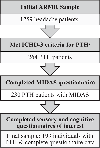Sensory hypersensitivities are associated with post-traumatic headache-related disability
- PMID: 37638410
- PMCID: PMC10854013
- DOI: 10.1111/head.14604
Sensory hypersensitivities are associated with post-traumatic headache-related disability
Abstract
Objective: To examine whether sensory hypersensitivity contributes to headache-related disability in a secondary analysis of patients with post-traumatic headache.
Background: Up to one-third of individuals with traumatic brain injuries report persistent headache 3 months post-injury. High rates of allodynia and photophobia have been observed in clinical studies and animal models of post-traumatic headache, but we do not fully understand how sensory amplifications impact post-traumatic headache-related disability.
Methods: We identified a cross-sectional sample of patients from the American Registry for Migraine Research database with new or worsening headaches post-head injury from 2016 to 2020 and performed a secondary analysis of those data. We modeled the relationship between sensory sensitivity and Migraine Disability Assessment scores using questionnaires. Candidate variables included data collection features (study site and year), headache-related and general clinical features (headache frequency, migraine diagnosis, abuse history, sex, age, cognitive and affective symptom scores), and sensory symptoms (related to light, sound, and touch sensitivity).
Results: The final sample included 193 patients (median age 46, IQR 22; 161/193, 83.4% female). Migraine Disability Assessment scores ranged from 0 to 260 (median 47, IQR 87). The final model included allodynia, hyperacusis, photosensitivity, headache days per month, abuse history, anxiety and depression, cognitive dysfunction, and age (R2 = 0.43). An increase of one point in allodynia score corresponded to a 3% increase in headache disability (95% CI: 0%-7%; p = 0.027), an increase of one-tenth of a point in the photosensitivity score corresponded to a 12% increase (95% CI: 3%-25%; p = 0.002), and an increase of one point in the hyperacusis score corresponded to a 2% increase (95% CI: 0%-4%; p = 0.016).
Conclusions: Increased photosensitivity, allodynia, and hyperacusis were associated with increased headache-related disability in this sample of patients with post-traumatic headache. Symptoms of sensory amplification likely contribute to post-traumatic headache-related disability and merit an ongoing investigation into their potential as disease markers and treatment targets.
Keywords: allodynia; concussion; hyperacusis; photophobia; post-traumatic headache; traumatic brain injury.
© 2023 American Headache Society.
Conflict of interest statement
CONFLICT OF INTEREST STATEMENT
Similar articles
-
Impact of abuse on migraine-related sensory hypersensitivity symptoms: Results from the American Registry for Migraine Research.Headache. 2021 May;61(5):740-754. doi: 10.1111/head.14100. Epub 2021 Mar 29. Headache. 2021. PMID: 33779989
-
Clinical correlates of insomnia in patients with persistent post-traumatic headache compared with migraine.J Headache Pain. 2020 Apr 15;21(1):33. doi: 10.1186/s10194-020-01103-8. J Headache Pain. 2020. PMID: 32295535 Free PMC article.
-
Sensory Hypersensitivity Symptoms in Migraine With vs Without Aura: Results From the American Registry for Migraine Research.Headache. 2020 Mar;60(3):506-514. doi: 10.1111/head.13745. Epub 2020 Jan 22. Headache. 2020. PMID: 31965576
-
Persistent post-traumatic headache: a migrainous loop or not? The clinical evidence.J Headache Pain. 2020 May 24;21(1):55. doi: 10.1186/s10194-020-01122-5. J Headache Pain. 2020. PMID: 32448142 Free PMC article. Review.
-
Premonitory and Accompanying Symptoms in Childhood Migraine.Curr Pain Headache Rep. 2022 Feb;26(2):151-163. doi: 10.1007/s11916-022-01015-z. Epub 2022 Jan 22. Curr Pain Headache Rep. 2022. PMID: 35064917 Review.
Cited by
-
Increased occurrence of migraine aura and susceptibility to spreading depolarizations at altitude.medRxiv [Preprint]. 2025 Aug 13:2025.08.09.25333153. doi: 10.1101/2025.08.09.25333153. medRxiv. 2025. PMID: 40832422 Free PMC article. Preprint.
References
-
- Centers for Disease Control and Prevention. Report to Congress on Traumatic Brain Injury in the United States: Epidemiology and Rehabilitation. National Center for Injury Prevention and Control; Division of Unintentional Injury Prevention; 2014. Accessed July 26, 2022. https://www.cdc.gov/traumaticbraininjury/pubs/congress_epi_rehab.html
MeSH terms
Grants and funding
LinkOut - more resources
Full Text Sources
Medical


